

How Volcanoes Form. Volcano - The shape of the land, Forces and changes, Spotlight on famous forms, For More Information. Photo by: Beboy Volcanoes are landforms whose shapes may remain unchanged for centuries or may change drastically in minutes.
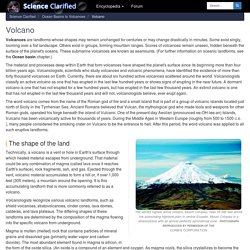
Some exist singly, looming over a flat landscape. Others exist in groups, forming mountain ranges. Scores of volcanoes remain unseen, hidden beneath the surface of the planet's oceans. These submarine volcanoes are known as seamounts. The material and processes deep within Earth that form volcanoes have shaped the planet's surface since its beginning more than four billion years ago. Volcanic activity. On this page: Volcanoes affecting our region, volcanic hazards, monitoring, what we are doing, useful links Volcanic activity threatens people and property.
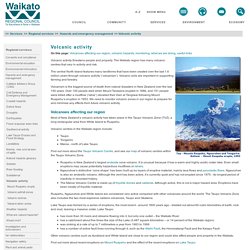
The Waikato region has many volcanic centres that vary in activity and risk. The central North Island features many landforms that have been created over the last 1.6 million years through volcanic activity (‘volcanism’). Volcanic soils are important in supporting farming and forestry. Volcanism is the biggest source of death from natural disasters in New Zealand over the last 150 years. Volcanoes affecting our region Most of New Zealand’s volcanic activity has taken place in the Taupo Volcanic Zone (TVZ), a long rectangular area from White Island to Ruapehu. Volcanic centres in the Waikato region include: Geology – overview. New Zealand is part of a continent called Zealandia, most of which is under the ocean.
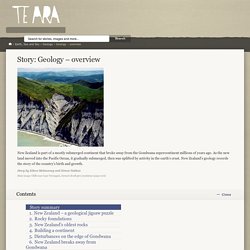
The country lies across two moving plates – segments of the earth’s crust. As these plates collide, rocks are being pushed up, creating hills and mountains, including the Southern Alps. Types of rock Most of the South Island is made of a rock known as greywacke. It contains fossils that show that the island was once under the sea. Eruption of Mt Tarawera. The eruption lasted six hours and caused massive destruction.

Several villages were destroyed, along with most of the famous silica hot springs known as the Pink and White Terraces. Approximately 120 people, nearly all Māori, lost their lives. Eleven days before the eruption, passengers travelling on a tourist boat with the renowned guide Sophia Hinerangi reported seeing a phantom war canoe on Lake Tarawera. Tribal elders believed this was a waka wairua (spirit canoe) – an omen of doom. More tangible signs included an increase in hot spring activity and surges in the lake’s level.
In the early hours of 10 June, people awoke to earthquakes, lightning, fountains of molten rock, and columns of smoke and ash up to 10 km high. A 17-km-long rift split Mt Tarawera and extended as far south as Waimangu. Effects of the 1995-1996 Ruapehu eruptions. The Australasian Journal of Disaster and Trauma Studies ISSN: 1174-4707 Volume : 2001-1 Effects of the 1995-1996 Ruapehu eruptions on communities in central North Island, New Zealand, and people's perceptions of volcanic hazards after the event.

Julia Becker, IGNS, Wairakei Research Centre, Private Bag 2000, Taupo, New Zealand Email: j.becker@gns.cri.nz Richard Smith, Department of Earth Sciences, The University of Waikato, Hamilton, New Zealand Email: rt.smith@waikato.ac.nz David Johnston, IGNS, Wairakei Research Centre, Private Bag 2000, Taupo, New Zealand. Email: D.Johnston@gns.cri.nz Adam Munro,Environment Waikato, Hamilton, New Zealand. Email: hazardlink @sk.sympatico.ca Keywords: Mt Ruapehu, eruption, physical and social impacts Julia Becker (1*), Richard Smith (1), David Johnston (2) & Adam Munro (3) Introduction During September and October of 1995, a series of ash-producing eruptions occurred at Mt Ruapehu.
The 1995-1996 Ruapehu eruptions had some positive side effects. Method. Types of volcanic rock. Rocks are not all the same.
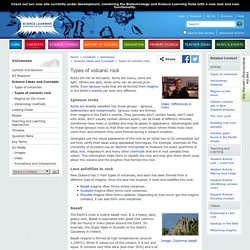
Some are heavy, some are light. Others are dark, while some can be almost pure white. Even igneous rocks that are all formed from magma in the Earth’s mantle can look very different. Igneous rocks Rocks are broadly classified into three groups – igneous, sedimentary and metamorphic. Geologists use the visual appearance of the rock as an initial clue to its composition but will then verify their ideas using specialised techniques. Lava solidifies to rock. The Geology of New Zealand / Regional Geology / Earth Science / Our Science / Home - GNS Science. Weather Wiz Kids weather information for kids. Volcanoes (Volcanoes are not associated with weather, but instead are natural disasters.)
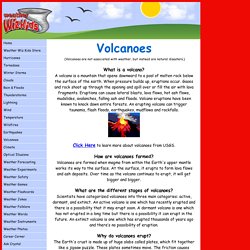
What is a volcano? A volcano is a mountain that opens downward to a pool of molten rock below the surface of the earth. When pressure builds up, eruptions occur. Gases and rock shoot up through the opening and spill over or fill the air with lava fragments. Eruptions can cause lateral blasts, lava flows, hot ash flows, mudslides, avalanches, falling ash and floods. Click Here to learn more about volcanoes from USGS. How are volcanoes formed? What are plate tectonics? Click Here to learn more about plate tectonics and the drifting of our continents. How many volcanoes are there? What are the different types of volcanoes? What is the difference between lava and magma? Why does lava take a long time to cool down?
What is a pyroclastic flow? What is lahar? What is pumice? What is the largest active volcano? Why are there volcanoes in New Zealand? Including Tarawera,Taupo,Ruapehu,White Island and Tongariro. World volcano Profiles >New Zealand.
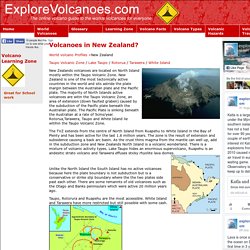
New Zealand volcanoes. New Zealand has volcanoes stretching from the Bay of Islands down to Otago.

Many of our volcanoes are extinct (no longer active), some are dormant (not active but capable of becoming active) and some are active – meaning they still erupt from time to time. There have been some famous volcanic eruptions in our country’s history: One of the world’s largest explosions in the last 5000 years happened when volcanic vents in the Taupō region erupted. The huge crater that was left filled with water and formed Lake Taupō. Volcanoes / Natural Hazards / Our Science / Home - GNS Science. There are 12 active volcanic areas in New Zealand.
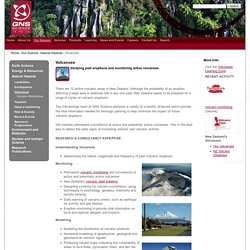
Although the probability of an eruption affecting a large area is relatively low in any one year, New Zealand needs to be prepared for a range of styles of volcanic eruptions. The Volcanology team at GNS Science performs a variety of scientific analyses which provide the vital information needed for thorough planning to help minimise the impact of future volcanic eruptions. We maintain permanent surveillance at active and potentially active volcanoes - this is the best way to detect the early signs of increasing seismic and volcanic activity.